The Disposable Electric Toothbrushes Market is estimated to be valued at USD 3.8 billion in 2025 and is projected to reach USD 8.2 billion by 2035, registering a compound annual growth rate (CAGR) of 8.1% over the forecast period.
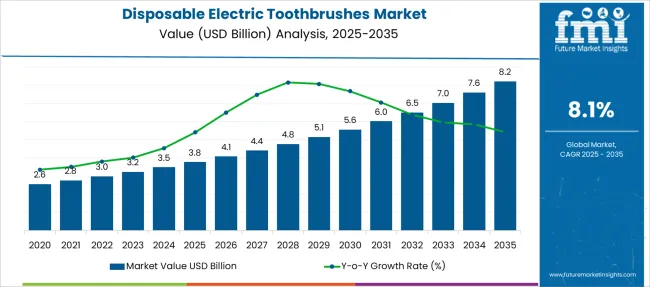
| Metric | Value |
|---|---|
| Disposable Electric Toothbrushes Market Estimated Value in (2025 E) | USD 3.8 billion |
| Disposable Electric Toothbrushes Market Forecast Value in (2035 F) | USD 8.2 billion |
| Forecast CAGR (2025 to 2035) | 8.1% |
The disposable electric toothbrushes market is experiencing accelerated growth due to rising consumer demand for convenient, hygienic, and travel-friendly oral care solutions. Growing awareness about dental hygiene and the increasing affordability of electric toothbrush technology have supported a wider adoption of disposable variants. These toothbrushes offer a balance between manual toothbrush pricing and the performance benefits of electric models, making them attractive in both developed and emerging economies.
The surge in e-commerce platforms and retail expansion has enabled deeper market penetration, especially among first-time users and health-conscious consumers. Additionally, the global emphasis on infection control and personal hygiene in the aftermath of recent public health concerns has increased demand for single-user, replaceable products.
The integration of basic motorized features with compact, lightweight designs has helped brands cater to convenience-seeking consumers, while also aligning with lifestyle-driven consumption Over the coming years, increased innovation in battery life, recyclable components, and retail accessibility is expected to further propel market growth.
The market is segmented by Product Type, Application, End Users, Movement Speed, and Sales Channels and region. By Product Type, the market is divided into Rechargeable, Battery, and Ultrasound. In terms of Application, the market is classified into Side by side, Rotational, Vibrational, and Others. Based on End Users, the market is segmented into Adults and Kids. By Movement Speed, the market is divided into Sonic and Power. By Sales Channels, the market is segmented into Online and Offline. Regionally, the market is classified into North America, Latin America, Western Europe, Eastern Europe, Balkan & Baltic Countries, Russia & Belarus, Central Asia, East Asia, South Asia & Pacific, and the Middle East & Africa.
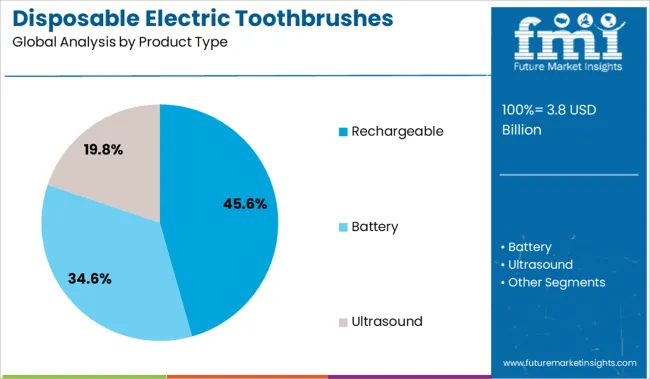
The rechargeable segment is projected to hold 45.6% of the disposable electric toothbrushes market revenue share in 2025, driven by its ability to offer both functionality and cost-efficiency. The segment's dominance has been shaped by rising consumer interest in sustainable oral care practices and products that deliver longer usage cycles.
Rechargeable toothbrushes within the disposable segment have gained popularity for their compact size, integrated battery life, and effective plaque removal features, while maintaining a price point suitable for mass adoption. Consumers are increasingly choosing rechargeable variants over purely single-use models due to their ease of reusability for short-term travel or short-duration use cases.
The ability to combine minimal charging infrastructure with low maintenance has contributed to the appeal of this product type Retailers and manufacturers have emphasized this segment as a middle ground between long-term electric toothbrush investments and traditional disposable items, allowing users to benefit from improved oral care outcomes without incurring high replacement or maintenance costs.
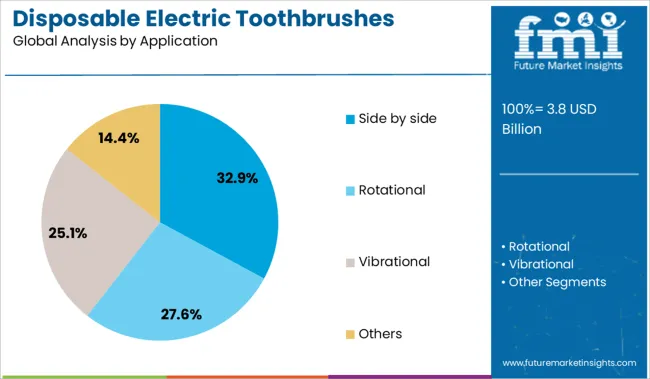
The side by side application segment is anticipated to represent 32.9% of the total revenue share in the disposable electric toothbrushes market in 2025, reflecting its importance in multi-user household settings. This application type has gained traction as families increasingly seek cost-effective and hygienic brushing solutions that can be easily distributed among members.
The segment’s growth is being driven by the packaging and marketing of toothbrush sets tailored for couples, siblings, or group travel. Manufacturers have responded by offering multipack options and color-coded variants that allow for shared usage contexts without compromising personal hygiene.
The convenience of synchronized usage, combined with the affordability and disposability of these toothbrushes, has made this segment particularly relevant in modern households where shared bathrooms and coordinated routines are common Additionally, retail promotions and bulk purchasing incentives have further increased adoption in this category, enabling value-driven consumption without sacrificing performance or hygiene standards.
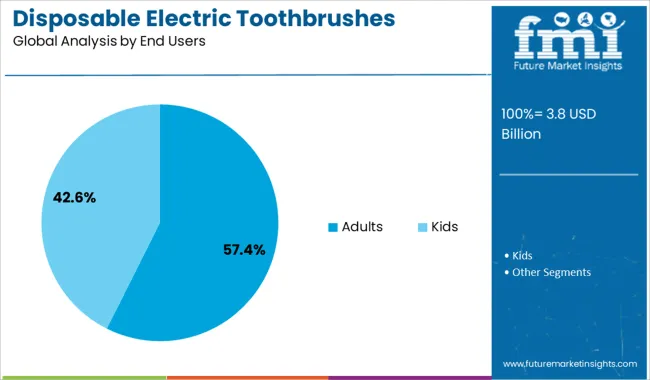
The adults segment is expected to capture 57.4% of the total revenue share in the disposable electric toothbrushes market by 2025, making it the largest end-use category. This segment's expansion is being influenced by a growing emphasis on preventive dental care and the adoption of simplified oral hygiene tools among adult consumers. The demand from working professionals, frequent travelers, and health-conscious individuals has reinforced the preference for compact, efficient, and single-user toothbrush options that align with modern lifestyles.
Adults are increasingly turning to disposable electric toothbrushes as secondary tools for travel or as introductory devices before upgrading to premium models. In addition, manufacturers have designed adult-focused versions that offer improved bristle quality, soft-touch grips, and performance-oriented brushing modes while remaining disposable and affordable.
Marketing efforts highlighting time efficiency and hygiene assurance have also contributed to the strong uptake in this demographic As oral care awareness rises and convenience remains a primary purchase driver, the adults segment is expected to sustain its leading role in shaping demand dynamics across the market.
The global disposable electric toothbrush market is being driven by increased awareness about oral hygiene and periodontal illnesses, such as plaque build-up to extend the life of the teeth. Growing oral health concerns among seniors, patients, and children as a result of periodontal disease are encouraging the use of oral hygiene products, resulting in a surge in demand for disposable electric toothbrushes.
According to the Centres for Disease Control and Prevention (CDC), periodontal disease affects 50 percent of Americans aged 30 and up, or around 64.7 million people. As a result, rising consumer awareness of the benefits of disposable electric toothbrushes is propelling the sales of disposable electric toothbrushes.
The expensive cost of disposable electric toothbrushes, as compared to manual toothbrushes, may be a stumbling block to their growth. Disposable electric toothbrushes are also available, with prices ranging from USD 15 to USD 25.
Finding the best disposable electric toothbrush is difficult due to the small number of players on the market, hampering the sales of disposable electric toothbrushes. Manual toothbrushes, on the other hand, are less expensive. They normally cost between USD 1 and USD 3.
Growing customer demand for sophisticated oral hygiene products, as well as an increase in the middle-class population's disposable cash, has resulted in a shift in customer attitudes about the treatment of dental problems around the world. As a result, sales of disposable electric toothbrushes were positively impacted.
As a result, companies are concentrating their efforts on introducing revolutionary advanced oral care goods to the market, expanding the demand for disposable electric toothbrushes.
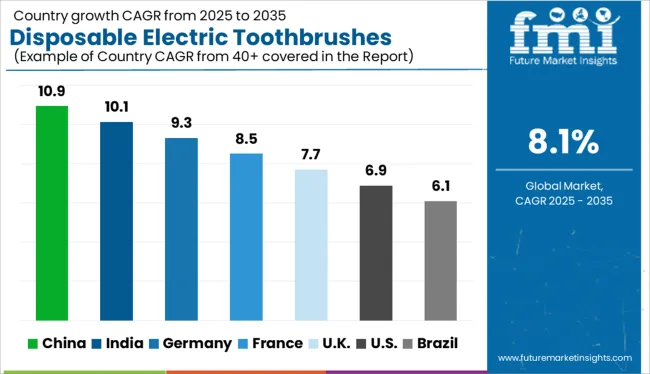
During the projected period, the disposable electric toothbrush market is expected to develop at a healthy rate across all geographies. The global health, hygiene, and wellness industries are expected to drive demand for disposable electric toothbrushes.
East Asia has a considerable market share for disposable electric toothbrushes, and the disposable electric toothbrushes market is predicted to rise at a significant rate due to increased awareness about oral health. The emerging markets of China and India are likely to boost the sales of disposable electric toothbrushes.
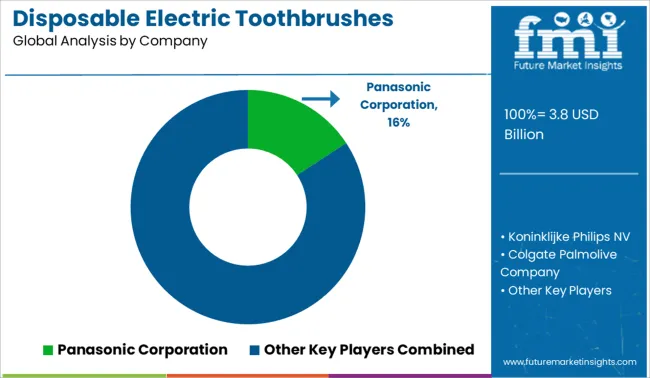
Some of the major players in the disposable electric toothbrushes market are Arm & Hammer, Colgate Palmolive Company, Proctor and Gamble, and others holding a substantial disposable electric toothbrushes market share.
Disposable electric toothbrush manufacturers are concentrating on developing new items. The market is being driven by the use of sonic and ultrasonic technology in the manufacture of electric toothbrushes.
| Report Attribute | Details |
|---|---|
| Growth rate | CAGR of 8.1% from 2025 to 2035 |
| The base year for estimation | 2024 |
| Historical data | 2020 to 2024 |
| Forecast period | 2025 to 2035 |
| Quantitative units | Revenue in USD billion, volume in kilotons, and CAGR from 2025 to 2035 |
| Report Coverage | Revenue forecast, volume forecast, company ranking, competitive landscape, growth factors, and trends, Pricing Analysis |
| Segments Covered | Bristle type, end user, sales channel, region |
| Regional scope | North America; Western Europe; Eastern Europe; Middle East; Africa; ASEAN; South Asia; Rest of Asia; Australia; and New Zealand |
| Country scope | USA, Canada, Mexico, Germany, United Kingdom, France, Italy, Spain, Russia, Belgium, Poland, Czech Republic, China, India, Japan, Australia, Brazil, Argentina, Colombia, Saudi Arabia, United Arab Emirates(UAE), Iran, South Africa |
| Key companies profiled | Arm & Hammer; The Proctor and Gamble; Colgate Palmolive Company; and others. |
| Customization scope | Free report customization (equivalent to up to 8 analysts' working days) with purchase. Addition or alteration to country, regional & segment scope. |
| Pricing and purchase options | Avail customized purchase options to meet your exact research needs. |
The global disposable electric toothbrushes market is estimated to be valued at USD 3.8 billion in 2025.
The market size for the disposable electric toothbrushes market is projected to reach USD 8.2 billion by 2035.
The disposable electric toothbrushes market is expected to grow at a 8.1% CAGR between 2025 and 2035.
The key product types in disposable electric toothbrushes market are rechargeable, battery and ultrasound.
In terms of application, side by side segment to command 32.9% share in the disposable electric toothbrushes market in 2025.






Full Research Suite comprises of:
Market outlook & trends analysis
Interviews & case studies
Strategic recommendations
Vendor profiles & capabilities analysis
5-year forecasts
8 regions and 60+ country-level data splits
Market segment data splits
12 months of continuous data updates
DELIVERED AS:
PDF EXCEL ONLINE
Disposable Medical Gowns Market Size and Share Forecast Outlook 2025 to 2035
Disposable Drills Market Size and Share Forecast Outlook 2025 to 2035
Disposable Food Containers Market Size and Share Forecast Outlook 2025 to 2035
Disposable Protective Apparel Market Size and Share Forecast Outlook 2025 to 2035
Disposable Plates Market Size and Share Forecast Outlook 2025 to 2035
Disposable Hygiene Adhesives Market Size and Share Forecast Outlook 2025 to 2035
Disposable Umbilical Cord Protection Bag Market Size and Share Forecast Outlook 2025 to 2035
Disposable E-Cigarettes Market Size and Share Forecast Outlook 2025 to 2035
Disposable Pen Injectors Market Size and Share Forecast Outlook 2025 to 2035
Disposable Trocars Market Analysis - Size, Share, and Forecast Outlook 2025 to 2035
Disposable Cups Market Size and Share Forecast Outlook 2025 to 2035
Disposable Barrier Sleeves Market Size and Share Forecast Outlook 2025 to 2035
Disposable Plastic Pallet Market Size and Share Forecast Outlook 2025 to 2035
Disposable Curd Cups Market Size and Share Forecast Outlook 2025 to 2035
Disposable Egg Trays Market Size and Share Forecast Outlook 2025 to 2035
Disposable Blood Pressure Cuffs Market Analysis - Size, Share & Forecast 2025 to 2035
Disposable Cutlery Market Size, Growth, and Forecast 2025 to 2035
Disposable Spinal Instruments Market Analysis - Size, Share, and Forecast 2025 to 2035
Disposable Lids Market Analysis - Growth & Forecast 2025 to 2035
Disposable Face Mask Market Insights – Growth & Demand 2025 to 2035

Thank you!
You will receive an email from our Business Development Manager. Please be sure to check your SPAM/JUNK folder too.
Chat With
MaRIA